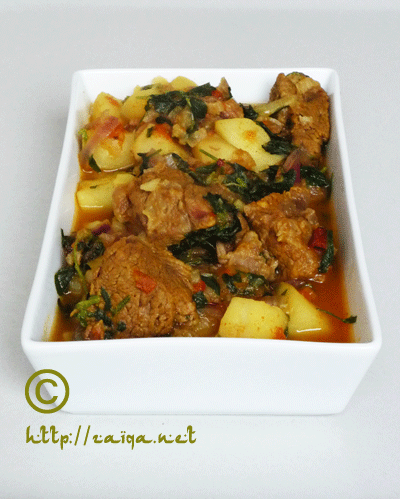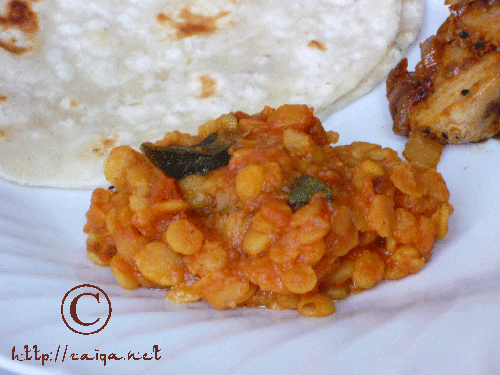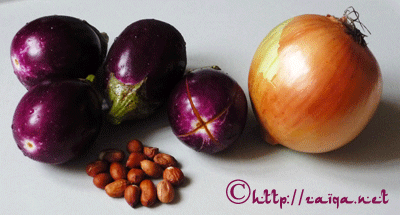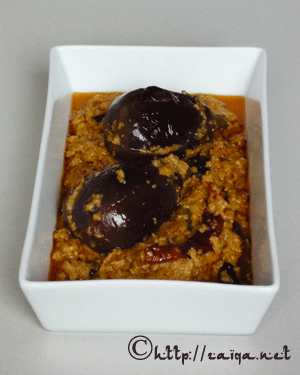It snowed here very heavily this year on Eid-ul-Adha, and I thought it would be best to cook a warming and nourishing brunch for the next day in the morning. My father in law recalled his good old times while we were having Nihari as our breakfast. He recollected that when he was a school going kid, his father would ask him to get up very early if he would like to join him for a breakfast of Nihari at Shehran Hotel, beside Charminar in Hyderabad. He also added he always loved the Nihari at Shahran and devoured it and still remembers the scrumptious taste. Always so many memories associated with food.
Some of the traditional dishes prepared by muslims just after Qurbani on Eid-ul-Adha are Nihari, Maghaz Masala, Organ meat and various kinds of the red meat preparations from the Qurbani ka gosht.
Nihari, also sometimes referred to as Nahari or Sir-e-Paaya (plural is Sir-e-paaye) (sir means head and paaya means legs), is a rich broth, made out the bones and meat of a sheep or lamb’s cheek and head bones and the tongue meat and shanks. It has a special mention in the must-taste list of travelers visiting the city around Eid. In Hyderabad, after the Qurbani, my father would take the sheep’s head and feet to the butcher for further preparations so that we could prepare Nihari. The butcher used to roast the ‘whole head with skin and hairs on’ (sir) and the legs (paaya) in open fire to kill all the disease-causing agents if present, and to burn the hairs, and roast the skin to intensify its flavors. The butcher would then scrape off the burnt hairs, discard the waste parts and whack them all up into small pieces. The meat from the sheep’s cheeks is substantial and most tender and delectable. Its tongue takes a longer time to get cooked, but is a delicacy. The butchers here in Toronto do sell the head and legs of the sheep, but with the skin removed. The real taste of the Nihari is due to the fire roasted skin which is not available here, so I really enjoy the true Nihari whenever I visit my parents in Hyderabad.
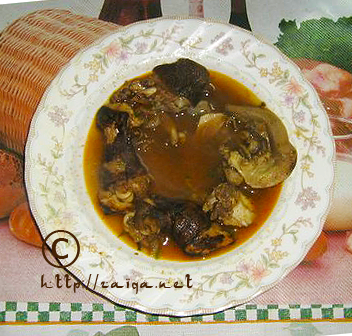
Nihari prepared using fire-roasted lamb trotters and head pieces with skin
Nihari is prepared by boiling or slow cooking the sheep bones and meat along with a range of ambrosial spices and herbs. Earlier, people used to slow cook it on coal in large pots the whole night long, until the broth was thick and flavorsome by morning ready for the breakfast, the the bones so soft you can literally chew them. Today, women use pressure cookers to save time.
The Hyderabadi Potli ka Masala or bouquet garni for Nihari contains a mixture of around 20 or more aromatic herbs and exotic spices which are tied in a muslin cloth and tossed into the saucepan to infuse wonderful flavors and a beautiful fragrance into the boiling broth. The Potli ka Masala contains but is not limited to spices such as:
1. Coriander seeds (Dhaniya)
2. Bayleaf (Tej Patta)
3. Sandalwood powder (Sandal ka powder)
4. Stone Flowers (Pathar ka Phool)
5. Star Anise (Dagad Phool)
6. Dried Rose Petals (Sukhe Gulab ke Phool)
7. Roots of the Betel plant (Paan ki jad)
8. Black Peppercorns (Sabut Kali Mirch)
9. Chinese Cubeb (Kawabchini)
10. Spiked Ginger Lily (Kapoor Kachri)
11. Black Cardamom (Badi Elaichi)
12. Salt (Namak)
13. Garam Masala
14. Cinnamon sticks (Dalchini)
15. Fennel seeds (Saunf)
16. Cloves (Laung)
17. Mace
18. Cumin seeds (Zeera)
19. Roasted Chana Dal (Phula Chana)
20. Dried Vetevier roots (Khas ki Jad)
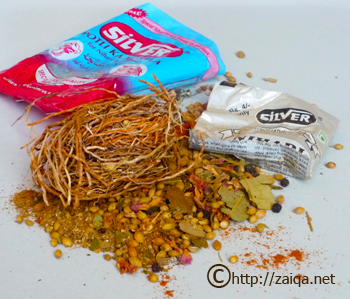
Ready made Potli Ka Masala from a store in Hyderabad,
containing various aromatic dried herbs and spices
You do not have to go searching for all these herbs to make your own Potli ka Masala. It is available ready made at many specialty stores in Hyderabad, especially in the Old city, a 25 gm potli ka masala costs around 10 Indian Rupees per packet. This Potli ka Masala or Nihari masala is also easily available in Indian grocery stores. I do not recommend buying the ‘Nihari powder’ from the market, instead go for the one that also contains the whole spices. Use any of the brands that you get your hands on. In the ready made Potli Ka Masala packets available in the markets, there is again a small packet inside called as the Nihari Masala powder, which consists of the powdered masala used in the second stage in the cooking process for Nihari.
What I do is, whenever I visit Hyderabad, I buy many packets from Hyderabad and get them with me here, so that they last me a long time, and freeze them to store and use whenever fancied.
Almost every household in Hyderabad prepares Nihari as breakfast or brunch at the second or third day of Eid. Nihari is enjoyed by sousing soft and warm Kulcha or Naan or Paratha, or by dunking in crusty breads into the highly flavored and nourishing broth containing all the goodness.

Nihari, prepared using deskinned lamb trotters,
served along with warm Parathas in the Hot-Pot
Nihari is always prepared out the head bones, tongue & cheek meat and the shanks or trotters of a lamb or a sheep. The traditional Nihari is never prepared of boneless lamb meat or chicken. However people add the same Nihari masala to chicken and boneless meat broths to simulate the dish in other simpler forms.
Sir-e-Paaye ki Nihari – Aromatic Slurpy Broth of Lamb Shanks and Cheek Meat
Ingredients:
4 legs and a head of a sheep – cleaned (and fire roasted if using the trotters with skin), and whacked into pieces + a sheep’s Tongue/Zabaan – cleaned (or) Lamb Shoulder meat with bone cut into big chunks – 1 kg
Potli ka Masala – half the quantity in a 25 gm packet
Red onion (or) Yellow Onion – 1, large, roughly chopped
Cornflour/Gram flour – 3/4 cup, mixed with a small amount of water to make a smooth paste
Red chilli powder – 2 tsp
Salt – 2 1/4 tsp
Turmeric/Haldi – 1/4 tsp
Small green chillies – 6, each slit into half
For Tempering, Baghaar:
Canola oil – 2 tbsp
Yellow onion – 1, large, finely sliced
Ginger garlic paste – 1 1/2 tsp
For Garnish:
Cilantro – 1/2 cup, finely chopped
Ginger juliennes – 2 tsp
Lemon wedges – 1 cup
Saffron threads – a pinch
Lemon juice – 1/3 cup
Method:
1. Wash the sheep’s head bones, tongue and trotters or the shoulder meat in surplus water. Put them in a strainer for the water to drain away. Meanwhile, in a pressure cooker, add the roughly chopped red onion, the washed bones, tongue and trotters or the shoulder meat from the strainer and pour in 1.5 liter of water, red chilli powder and green chillies. Make a bouquet garni of the required amount of potli ka masala (not the powdered masala from the small packet, read about it above). Add this bouquet garni along with salt and turmeric and close the lid to pressure cook until the meat is tender. Later, open the lid and add corn/gram flour paste. Half cover the lid and let it slow cook for 15 minutes more. The broth is ready. Cover with lid and keep aside
2. During that time, prepare the baghaar. Take a medium sized non-stick frying pan at medium high heat and pour oil into it. Throw in the sliced onions, and stir fry them until they are golden brown in colour. Now add the ginger garlic paste to the fried onions and fry it along for about 2 minutes more stirring continously. Remove the pan from heat and keep aside.
3. Just before you are ready to serve it to everyone, add half the quantity of the nihari masala powder from the small packet of the store brought potli ka masala, and the baghaar to the broth in the pressure cooker and bring to a boil. Lift out the bouquet garni and squeeze it thoroughly. Discard it later. Let it cook half covered for 15 more minutes. Close the heat and pour the Nihari into a large serving bowl. Add lemon juice, saffron threads and ginger juliennes. Serve the lemon wedges in a separate small cup if anyone wishes for an extra zing. Enjoy!
Suggested Accompaniments: Enjoy Nihari along with warm Parathas or Naan for a sumptuous breakfast.
Luv,
Mona

